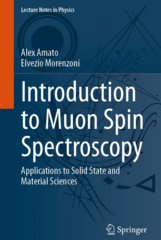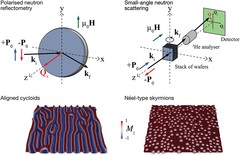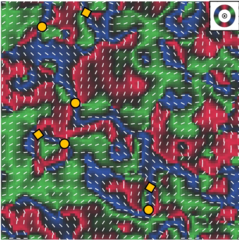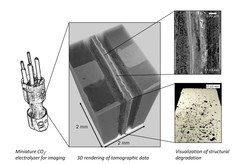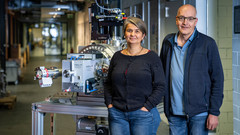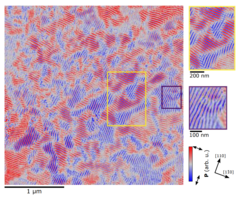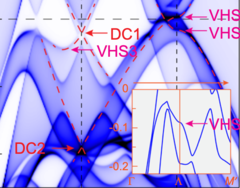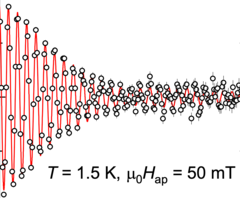Scientific Highlights
Charge fractionalisation observed spectroscopically
Quantum mechanics tells us that the fundamental unit of charge is unbreakable – but exceptions exist.
Introduction to Muon Spin Spectroscopy
Alex Amato and Elvezio Morenzoni (both NUM) have published a new textbook entitled 'Introduction to Muon Spin Spectroscopy: Applications to Solid State and Material Sciences'. The book is ideal for a first course in muon spin spectroscopy (µSR), comes enriched with exercises and solutions to master the subject and includes practical examples to quantify key experimental parameters.
Observation by SANS and PNR of pure Néel-type domain wall profiles and skyrmion suppression below room temperature in magnetic [Pt/CoFeB/Ru]10 multilayers
The study presents a unique investigation of [Pt/CoFeB/Ru]10 multilayers, revealing suppressed skyrmion phases, intricate magnetic domain structures, and Néel-type domain walls, providing crucial insights for spintronic applications.
Spatially reconfigurable topological textures in freestanding antiferromagnetic nanomembranes
Researchers from the University of Oxford have imaged, through the use of the soft X-ray microscopy capabilities at the Swiss Light Source, spatially reconfigurable antiferromagnetic states in topologically rich free-standing nanomembranes
Unraveling degradation processes in a bipolar membrane CO2 electrolyzer by time-resolved X-ray tomographic microscopy
Employing a bipolar ion conducting membrane (BPM) in forward bias is a convenient solution for the biggest issues in the more common anion exchange membrane (AEM) CO2 co-electrolysis: the degradation of the performance caused by carbonate salt precipitation at the cathode and the decrease of net CO2 conversion caused by the crossover of this molecule from cathode to anode also requiring energy for downstream gas separation. However, the performance and stability of this device remain largely insufficient when using such a BPM configuration. To understand the reasons for this, we performed time-resolved X-ray tomographic microscopy of an operating BPM CO2 electrolyzer. The imaging method reveals partly unexpected degradation processes that result in design recommendations for improvement.
Developing detectors to transform science with light (part 1)
Part I: How the Jungfrau detector went from inception to perfection to ubiquity.
Ptychographic Nanoscale Imaging of the Magnetoelectric Coupling in Freestanding Bismuth Ferrite Films
Through soft X-ray ptychographic imaging, researchers at the Swiss Light Source have directly imaged the magneto-electric coupling between the ferroelectric domain structure and the spin-cycloidal state in freestanding BiFeO3 thin films.
Phonon promoted charge density wave in topological kagome metal ScV6Sn6
Charge density wave (CDW) orders in vanadium-based kagome metals have recently received tremendous attention, yet their origin remains a topic of debate. The discovery of ScV6Sn6, a bilayer kagome metal featuring an intriguing √3 × √3 × √3 CDW order, offers a novel platform to explore the underlying mechanism behind the unconventional CDW. Here we combine ...
Tuning of the flat band and its impact on superconductivity in Mo5Si3−xPx
The superconductivity in systems containing dispersionless (flat) bands is seemingly paradoxical, as traditional Bardeen-Cooper-Schrieffer theory requires an infinite enhancement of the carrier masses. However, the combination of flat and steep (dispersive) bands within the multiple band scenario might boost superconducting responses, potentially explaining high-temperature superconductivity in cuprates and metal hydrides. Here, we report ...
Altermagnetism proves its place on the magnetic family tree
Experiments at the Swiss Light Source SLS prove the existence of a new type of magnetism, with broad implications for technology and research.

